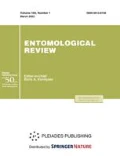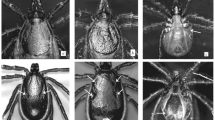Abstract
Variation of the exoskeleton is described for 2630 males of the taiga tick Ixodes persulcatus Schulze, 1930 collected by flagging from vegetation in the Far Eastern, Siberian, and Ural Federal Districts of Russia. Two types of conscutum anomalies were found to be prevalent in all the samples. Exoskeleton anomalies were less frequently recorded in the Far Eastern Federal District than in the Siberian and Ural Federal Districts: 6.5 ± 1.05, 29.7 ± 1.03, and 25.8 ± 3.93%, respectively. The observed phenotypic variation seems to be unrelated to anthropogenic impact. In the meridional direction, the taiga tick samples with different frequencies of exoskeleton anomalies correspond to two races of the species.
Similar content being viewed by others
References
Alekseev, A.N., “Anthropogenic Pressure, Vector Pathomorphology, and Abundance of the Lyme Disease Agent,” Doklady Rossiiskoi Akademii Nauk 340 (4), 563–565 (1995).
Alekseev, A.N., Dubinina, H.V., and Chirov, P.A., “Tick Morphology, Tick Microbiocenosis, and the Ability to Accumulate Tick-Borne Pathogens as a Result of Anthropogenic Pressure?” International Journal of Medical Microbiology 296 (1), 169–171 (2006).
Alekseev, A.N., Dubinina, E.V., and Yushkova, O.V., The Functioning of the Parasitic System of Ticks and Disease Agents under the Increasing Anthropogenic Pressure (Insanta, St. Petersburg, 2008) [in Russian].
Eliseeva, I.I. and Yuzbashev, M.M., General Theory of Statistics: a Manual (Finansy i Statistika, Moscow, 2004) [in Russian].
Korenberg, E.I., The Biochorological Structure of a Species: the Example of the Taiga Tick (Nauka, Moscow, 1979) [in Russian].
Korotkov, Yu.S., “Clinal Variation in the Parasite System of Tick-Borne Encephalitis,” Voprosy Virusologii 3 (50), 52–56 (2005).
Korotkov, Yu.S., Doctoral Dissertation in Biology (St. Petersburg, 2009).
Korotkov, Yu.S., Geographic Variability of Morphogenetic Diapause in Larvae and Nymphs of the Taiga Tick Ixodes persulcatus (Acarina, Ixodidae),” Parazitologiya 50 (1), 3–20 (2016) [Entomological Review 96 (5), 634–646 (2016)].
Morozov, I.M., Alekseev, A.N., Dubinina, E.V., Nikitin, A.Ya., Melnikova, O.V., and Andaev, E.I., “Polymorphism of the Phenotypic Structure of the Taiga Tick Population and Its Epidemiological Significance,” Meditsinskaya Parazitologiya i Parazitarnye Bolezni, No. 3, 42–45 (2015).
Panova, T.S., Candidate’s Dissertation in Biology (Irkutsk, 2011).
Pozdnyakov, A.A., “Criticism of the Epigenetic Theory of Evolution,” Zhurnal Obshchei Biologii 70 (5), 383–395 (2009).
Semenov, A.V., Candidate’s Dissertation in Biology (Moscow, 2003).
Author information
Authors and Affiliations
Corresponding author
Additional information
Original Russian Text © A.Ya. Nikitin, I.M. Morozov, 2017, published in Parazitologiya, 2017, Vol. 51, No. 1, pp. 38–44.
Rights and permissions
About this article
Cite this article
Nikitin, A.Y., Morozov, I.M. Exoskeleton anomalies in taiga tick males from populations of the Asian part of Russia. Entmol. Rev. 97, 251–254 (2017). https://doi.org/10.1134/S0013873817020105
Received:
Published:
Issue Date:
DOI: https://doi.org/10.1134/S0013873817020105




